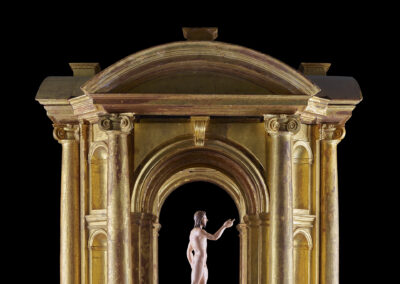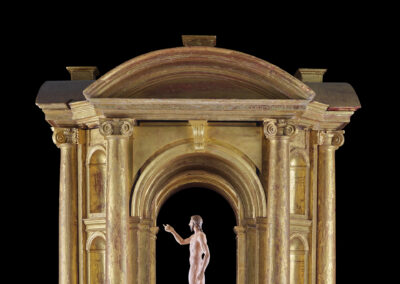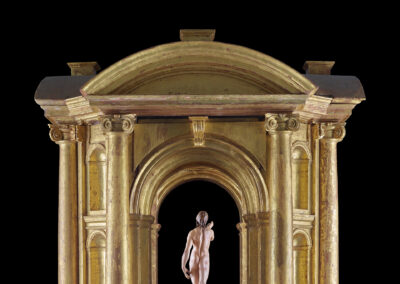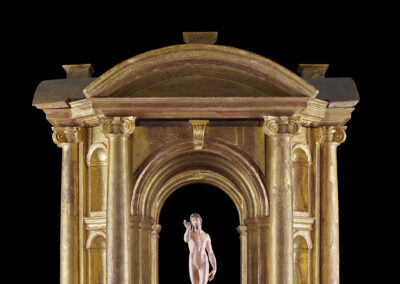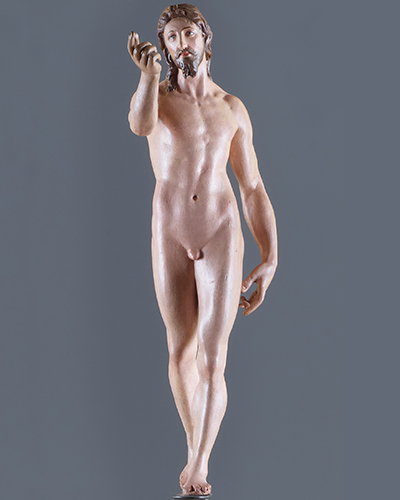El Greco designed and executed a tabernacle and monstrance, probably based on the double model of the Escorial monastery, for the altar of the provisional chapel of the Hospital Tavera - which was to be crowned with his sculpture of the Risen Christ - between 1595 and 1598, a work he would finish on the new high altar of the great chapel inaugurated in 1624. Shortly after it was completed, in 1608, Dominico designed and began work on the new main altarpiece and the two side altarpieces, which would have been a masterpiece of ecclesiastical decoration had the first altarpiece also been executed according to his designs and the canvases that the Cretan had designed had been placed on them.
Pedro Salazar de Mendoza (1549-1629), administrator of the hospital and friend of the painter, contracted the work which, when it was completed in 1598, gave rise to further arguments between the artist and his client. According to the contract, both were to appoint appraisers and in July they did so, respectively the carver Toribio González de la Sierra and the assembler Luis Navarro, and gave power of attorney to Pedro Lasso de la Vega to appoint a third if they failed to reach an agreement; the former valued the work at 8,950 reales and the latter at 21,950 reales.The former valued it at 8,950 reales and the latter at 21,712; in view of the discord, Don Pedro intervened, appointed the silversmith Francisco Merino as arbitrator and, with the help of a sculptor from Talavera de la Reina, Benito de Ureta, he proceeded to bring the sum to 25,000 reales in August. El Greco, faced with this situation, agreed to collect -".for the devotion I have for [the said hospital] and love of the said administrator"The artist had already been paid 13,800 reales by the Hospital Tavera, and the artist was content with a further 2,200 reales. However, this "grace"to its "amadoPedro Salazar, perhaps less disinterested than one might think, was not subscribed by Dominico until 30 December, more than four months after the appraisal in his favour, which he renounced because he did not want to "...".take advantage of it". It seems that, by refusing the more than 800 ducats that he was legally entitled to, he was doing himself a favour and avoiding the delay in collection if a lawsuit had finally been filed.
The work on the tabernacle consisted not only of the architectural structure that is still partly preserved in the Chapel, but also included five sculptural figures, a risen Christ and the four Doctors of the Church (Saint Jerome, Saint Gregory, Saint Ambrose and Saint Augustine), and twelve figures - made of fake marble and representing the apostles - that were to be placed in the small niches and which the artist never delivered. The "Cristo of the Resurrection"It did not top the dome of the tabernacle but rose above the box or monstrance for the forms, apparently suspended above the tomb substitute. This work as a whole, with its Michelangeloesque architecture - on the model of St. Peter's in Rome - and its sculpture was highly modern, evident both in the dynamism conferred by its lack of unity, its play of interior light and the interrelation - ultimately scenographic - of architecture and sculpture. The appraiser Navarro was right to point out as the most meritorious feature of the work "...".the work of making the traces and plans and the mastery, which is the most valued and where the said Dominican put a lot of work and care"This is a periphrasis of what we could summarise in an adjectival noun: global invention.
On the other hand, the resurrected Christ - polychrome in his flesh tones, almost white except for his black hair - is shown completely naked, in contrast to the ideas of decorum and propriety typical of the Counter-Reformation, facing the viewer in an attitude of serene divinity, in an example of simplicity of lines and constituting a beautiful model of bodily weightlessness and balance that the theme required.
Fernando Marías, January 2008


